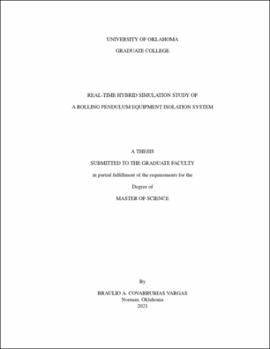| dc.description.abstract | Damage caused by earthquakes to buildings and their contents (e.g., sensitive equipment) can impact life safety and disrupt business operations following an event. The resulting social and economic losses can be minimized, or even eliminated, by reducing the seismic forces on building contents through vibration isolation. Floor isolation systems (FISs), in particular, are a promising retrofit strategy for protecting vital building contents. In this study, real-time hybrid simulation (RTHS) is utilized to validate mathematical models of isolation systems that incorporate multi-scale (building-FIS-equipment) interactions. For this, an experimental setup representing one bearing of a rolling pendulum (RP) based FIS is studied–first through characterization tests and then through RTHS. RHTS allows for numerically compensating for the extra mass in the experimental setup (m) through the equation of motion’s integration in MATLAB scripts and Simulink models.
A series of both type of tests were conducted at the Natural Hazards Engineering Research Infrastructure (NHERI) Experimental Facility at Lehigh University. Multiple excitations were used to study the experimental setup under uni-axial loading. In total, 240
tests among characterization and RTHS were performed. Details of the experimental testbed and test protocols for the characterization and RTHS tests are presented, along with results from these tests focused on the effect of enhanced damping on the rolling surface of a bearing, the FIS-equipment and building-FIS interactions and rigorous evaluation of different RP
isolation bearing designs through RTHS. All in all, it was found that the most optimal RP bearing configurations are those with coated with elastomeric rubber and higher tributary mass. For isolated equipment with a frequency of its own, it was found that the bearing's performance was affected for low-frequency equipment (i.e., 1 and 2 Hz at the base of the equipment). On the other hand, the effects of a FIS composed of 350 bearings and accounting for 5% of the structural floor mass were found to be negligible on the building studied (i.e., 3-story moment resisting frame). | en_US |
